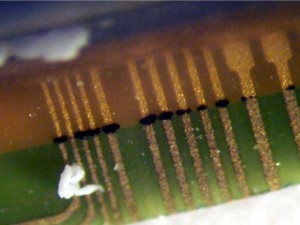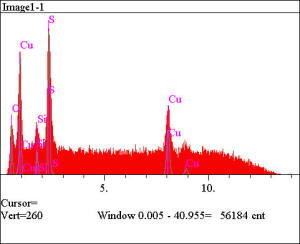Trace Line Corrosion
Gideon Analytical Laboratories performed failure analysis on several polyimide flex circuits with corrosion near an IC. As seen in the picture above left, the corrosion appeared as black outgrowth along the trace lines. These flex circuits allow for greater functional capacity and miniaturization while maintaining high reliability through quality and consistency. They can be used in the aerospace, automotive, computer data and processing, and consumer FTIR.
The picture above right is of SEM-EDS spectral analysis showing the corrosion area. There was no sulfur in the spectrum (coming from another source). The copper trace line had extended beyond the solder mask line and, therefore, exposed to the silicone encapsulate, which has a high moisture content. The copper oxidizes in the presence of moisture and voltage. There was enough energy present to drive this reaction. In order to form copper sulfide, one has to reduce the sulfate ion to extract the sulfur to react with the copper. This would require so much energy that one would melt the flex circuit.
The electrochemistry and spectra DID NOT support this type of reaction. The only reaction this evidence supports is a copper oxide (CuO). To eliminate this failure mechanism requires a barrier metal over the copper near the trace lines of the IC and a low absorbent polymer besides silicone surrounding the IC.
Using the results from failure analysis performed by Gideon Analytical Laboratories, electronics companies can alleviate problems with production or the field. Knowing how and why a failure occurs can be tremendously beneficial to manufacturers, vendors, and consumers alike. Failure analysis results in lower costs by solving and implementing a corrective action immediately. Call us with your needs.

Black Contamination at interface of gold and copper

EDS of corrosion by-product